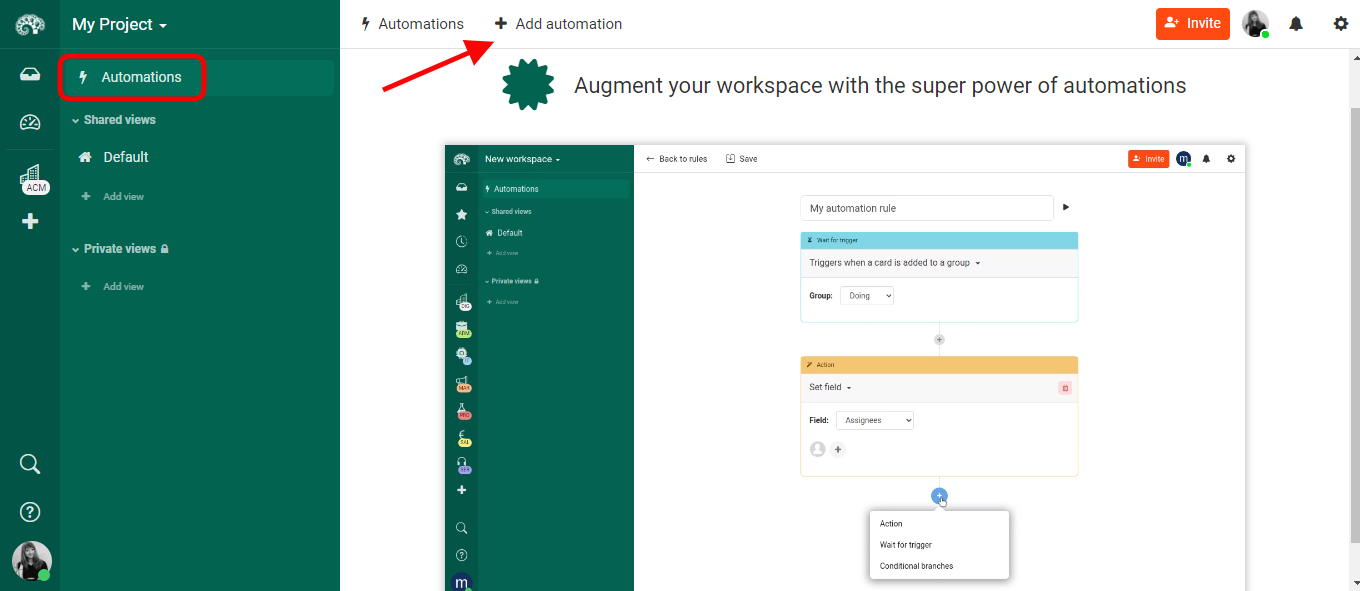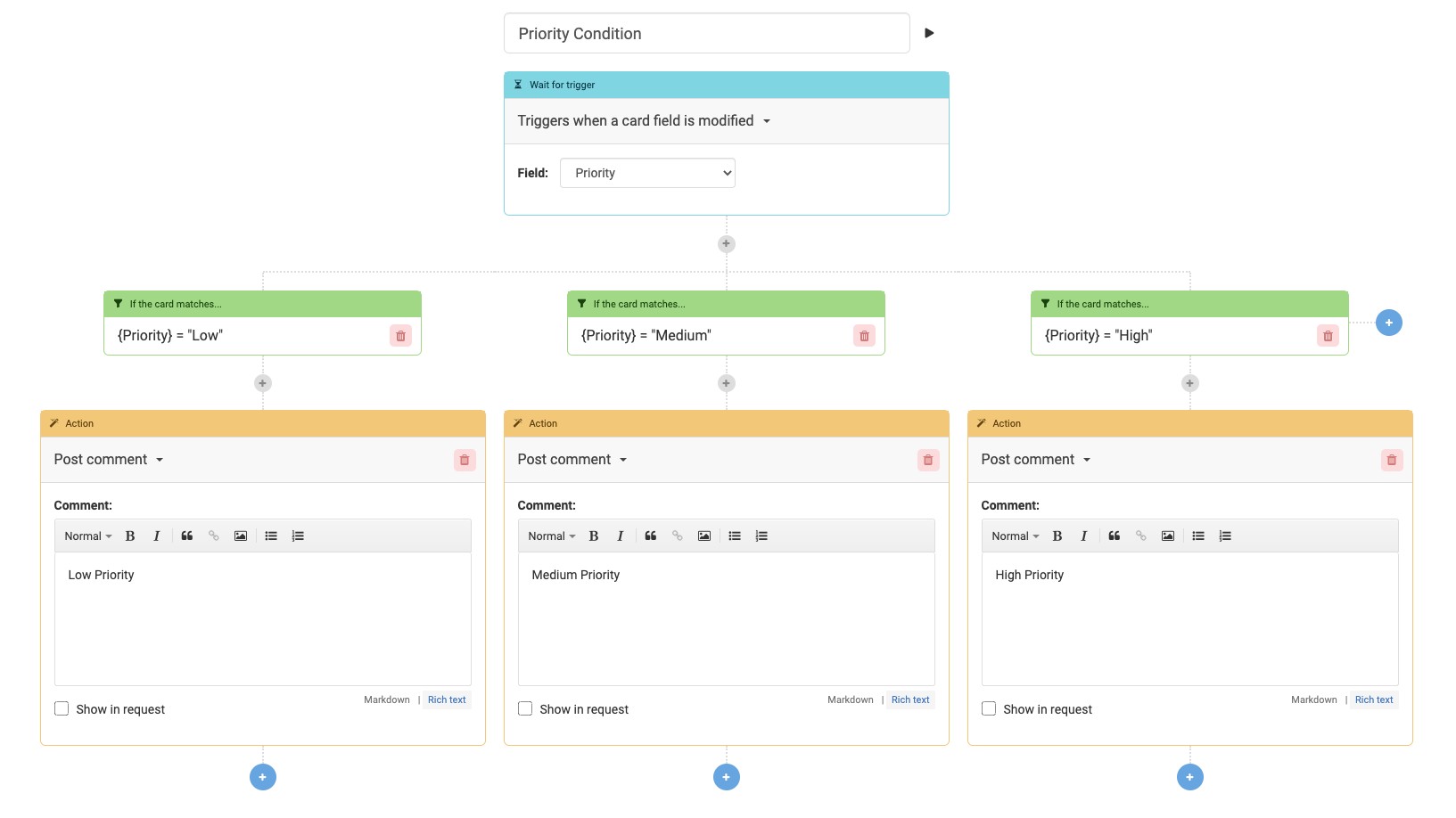Workflow automation gets an upgrade
In a previous release, we introduced a number of time-saving rules in Kantree: automated actions and recurring tasks. With this product update, we’re taking workflow automation a few steps further.
The improved automation system is designed to trigger actions on a wide variety of events and allow you to create complex workflows. It’s like giving your workspace super powers.

Let’s take a closer look at the changes and new tools, from a central automation page to action chains and conditional rules. But first…
What are workflow automations?
They are time-saving actions in your workflow, e.g. a kanban board, that only happen when triggered according to predefined rules. In other words, they’re automated commands for your workspace.
You can set up a single trigger/action automation or chain several actions to create a series of commands. The goal is to automate mundane or repetitive tasks and leave you more time to focus on high-value work.
For example, when a project card in your kanban workflow is moved from the “Doing” column to “For Review,” you can automate sending a notification to the person in charge instead of typing up an email each time.
Automations move to the project sidebar
Just like views and project forms, automations are now in the project sidebar on the left side of your workspace, easily accessible from anywhere in the project (they were previously attached to groups, e.g. the column menu in a kanban board).
The automation page is a hub where you can create, edit, and delete automation rules. It also gives you an overview of all the auto-actions in place, in fewer clicks.
 We’ve added an automation page to the project sidebar. It’s now a central place for viewing, adding, and editing automation rules.
We’ve added an automation page to the project sidebar. It’s now a central place for viewing, adding, and editing automation rules.
New auto action triggers added
We’ve added new triggers and actions to the system (pictured), so that you have a wide range of possibilities for workflow automation.
To create rules, go to the automation page and click “Add automation” at the top. Choose a trigger, then click on the ➕ icon to see available actions (or conditional branches, scroll down for details). When done, click “Save” and your rule will be active (if you want to pause it later, click the play button next to the rule).
 The new triggers give you a wide range of options for workflow automation.
The new triggers give you a wide range of options for workflow automation.
 To create automation rules, pair a trigger with an action from the list.
To create automation rules, pair a trigger with an action from the list.
Watch our short video to see these new tools in action. In this example, we’ll show how to create automation when a new request is submitted.
Action chains for complex workflows
With this release, we have also reworked action chains. You can now create a series of automation rules in a more visual way, combining triggers and actions.
To help you picture it, the basic idea is creating a tree of rules: event -> condition -> action. The tree allows you to link several actions together. A card in your workflow will only enter the tree by matching the first event.
Example: When a card in your kanban board is moved to the “Doing” column, you can automatically assign a teammate to this task (as mentioned earlier). With action chains, you can further automate the workflow by adding more commands. For instance, when the due date comes, the same card will get marked as “Done.”
More workflow power with “Wait for user action” option
Automation doesn’t mean your workspace will lose the human touch! The ability to add rules with extra triggers during the workflow allows you to wait for user actions to continue a rule. This is done with “Wait for user action.” For example, you assign someone to a card using automation then wait for that person to perform an action (e.g. add a label) to automatically continue.
 Adding “Wait for user action” to the tree of commands allows you to combine automation with a human touch to create truly custom and powerful workflows.
Adding “Wait for user action” to the tree of commands allows you to combine automation with a human touch to create truly custom and powerful workflows.
Conditional rules for even more automation
Going further, you can take advantage of conditional branches in rules using the Kantree Query Language (KQL). This allows you to evaluate variables in a card and set up very specific rules before an action is triggered.
Example: After creating a priority field in your cards (with the options of low, medium and high), you can create a priority condition in the automation page.
Add “Triggers when a card field is modified,” choose the priority field, then click on the ➕ icon to select “Conditional branches” and type a KQL condition. In this example, {Priority} = “Low”. Click on the ➕ below the condition and choose an action, such as “Publish a comment,” write a note and hit save. When a card is given low priority, Kantree will automatically publish a note in the comments section.
To add condition for medium priority, click the ➕ icon on the right, select “Add new branch based on condition,” and follow the steps above. Same for high priority.
 Using KQL in conditional branches, you can evaluate variables in a card and create specific rules before an auto action is triggered.
Using KQL in conditional branches, you can evaluate variables in a card and create specific rules before an auto action is triggered.
More control with manual triggering of rules
In certain situations, you may need to trigger an auto action on the spot instead of fully automating it. It’s possible thanks to the addition of a trigger button, which is another field you can add to your cards, then customize it to fit your project.
Example: Let’s say you’re managing a recruiting pipeline and you have an email that will be sent only to candidates you want to interview.
In the automations page, select “Manually trigger this rule” and check the box “Can only be triggered from a card (using a trigger button).” From the ➕ menu, choose “Post comment” and fill type your message that will be sent to qualified candidates via card comments. Next, add a trigger button to your cards, give it a name, and select an action you want to link to it (in this example, “Post comment”). When you’re ready to email a candidate, click on the trigger button in their card.
Pro tip: This function also allows you to move cards between Kantree workspaces or copy them from one workspace to another. It’s useful when you’re working with other teams or departments and share certain tasks.
Follow our public roadmap and be a part of building Kantree! Users can submit ideas and comment on in-progress items. Questions? Email us.